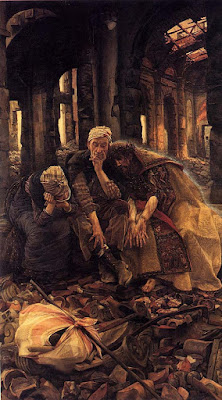The purpose of this post is to celebrate the work of the great 19th C. painter James Jacques Joseph Tissot (1836-1902), an artist who is often counted as a "realist" but also sometimes as a "Pre-Raphaelite" and often as an orientalist. It is his religious subjects and his attention to orientalist themes that recommends him here, although he made his name as a society painter and indeed many of his finest and most loved works are in that category. Famously, at around the age of forty-eight, in the Church of St. Sulpice, in Paris, while taking Mass, he experienced a religious vision that brought about his inner conversion to Catholicism and which, accordingly, reshaped the character of his work. Late in life, disgusted by the decadence of the nouveau riche who had been the subject of his earlier work, he journeyed to the Middle East and made extensive sketches and notes in preparation for a comprehensive series of paintings on the life of Christ. He finally completed no less than 350 scenes in this category, most of them watercolours, and over 700 Biblical illustrations in all, and exhibited them to both acclaim and controversy at the dawn of the 20th C. The whole series was subsequently purchased from public funds by the Brooklyn Museum in New York. Here is a photograph of the artist at his easel:
And here, more revealingly, is a self-portrait of the artist:
Yet more revealingly still, here is the oil painting Monsieur Tissot made immediately following his religious conversion in the Church of St. Sulpice. It is a mysterious work entitled The Ruins (Inner Voices):
We see an impoverished couple sitting in the ruins of a demolished building. With them, providing comfort, is Christ wearing a crown of thorns. This was the cornerstone of Tissot's visionary experience. From the time of this painting onwards he is a visionary artist whose account of the angelic interaction with the human in the life of Christ is especially profound. Here, for example, is his rendering of the Annunciation:
And here, more impressively - almost Blakean - is Christ ministered by angels:
A personal favourite, and a conceptually bold work, is the following depicting the view of Christ from the cross. That is, the artist has - controversially at the time - placed himself in the position of Christ and attempted to show a Christ-eye view from the crucifixion.
These works stand in stark contrast to those of his life before his religious conversion. This is what brings the present writer to the works of Monsieur Tissot in the first place. He - the present writer - is about to embark on a journey to Calcutta and it is in that context that he encountered the following painting by this artist, Ladies Aboard the HMS Calcutta, one of the painter's more "Pre-Raphaelite" works:

This is one of Tissot's many "waterfront" scenes. Prior to his religious works he specialised in depictions of gentlemen and ladies in waterfront and naval situations; that is, the nouveau riche in transit. These are the works that made him famous in his day. Some of them are quite splendid. Some of his earlier works are also odd. What is one to make of this painting, for example, Ladies in Chariots?:
The most impressive works, as far as the present writer is concerned, however, are those of overtly orientalist themes from the earlier career of this complex painter. Consider, for example, this painting from 1869 entitled Young Ladies Looking at Japanese Objects:
It is a work that captures the European fascination with the Orient - and Japan in particular - in an especially revealing manner. Although they are society pieces, or merely genre painting, these works, in fact, seem, more authentic, more penetrating, than the later visionary works. This is the strange thing about Monsieur Tissot. His religious conversion - although deep felt and yielding a prolific overflow of work - did not, in the end, induce art that one feels is great. A contemporary critique once described Tissot as an "unexciting enigma". This is the sad truth of it. Although his later work is visionary, his earlier work - which in the end disgusted him - was more complete and more compelling. It is a terrible irony.
Most terrible of all is the fact that, for the present writer, it is a simple oriental nude that strikes him as the most memorable and most perfect of the artist's works. This is the painting entitled The Japanese Bath, 1864.
Most terrible of all is the fact that, for the present writer, it is a simple oriental nude that strikes him as the most memorable and most perfect of the artist's works. This is the painting entitled The Japanese Bath, 1864.
It is, no question, a simple work of erotica, and an excuse to depict both the female form and the sensuality of oriental cloth, and yet it is surprisingly complete in itself, unaffected and ideal. It reveals and conceals, as a good nude should. By this simple criteria it is a particularly successful and unpretentious painting. It says something quite precise about the "orient" and the European gaze.
Yours
Harper McAlpine Black






















































